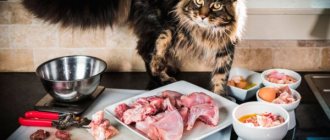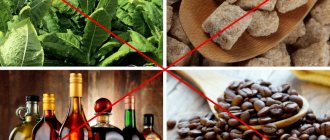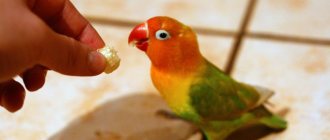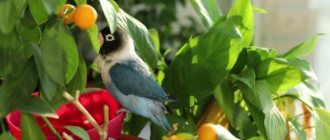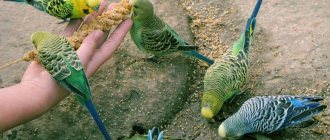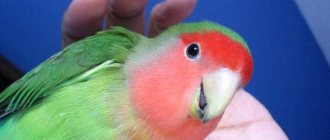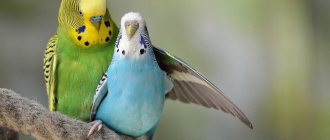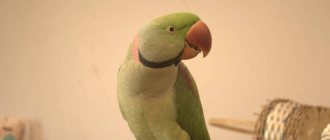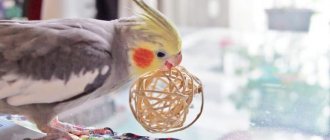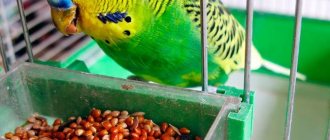Cockatiels are Australian crested parrots with developed intelligence and a peaceful disposition. Thanks to their memorable appearance and conversational abilities, the birds became popular far beyond their natural range, but did not change their eating habits. We will learn how to properly organize feeding a cockatiel and what foods should not be given to a parrot.
Diet in the wild
Corella parrots originated from Australia. They live in areas with steppe and forest-steppe terrain. Vegetation in these areas is planted with herbs and seeds, which are important for Corella’s nutrition.
What else do Corella parrots eat when living in natural conditions? They will happily eat the following types of food:
- Fruits of trees;
- Eucalyptus nectar;
- Ripe wheat grains;
- Millet.
What food do Corella parrots especially like? The menu should contain protein - insects. They replenish vitamins in the body and increase energy. They drink water in rivers and lakes.
What about people eating?
If you and your family eat healthy and nutritious food, your bird can eat it too. When doing so, follow the general recommendations discussed above and use common sense. Some parrots even enjoy a little lean cooked meat, fish, eggs or cheese on occasion. This is what cockatiels sometimes eat. Dairy products should be consumed in moderation. Common sense - avoid :
- unhealthy, sweet or salty foods,
- chocolate,
- products containing caffeine,
- alcoholic drinks.
What to feed your cockatiel parrot at home
Nutrition is an important part of life, which ensures the normal development of birds. It affects their health and condition. Therefore, every breeder should consider what to feed their cockatiels.
Hard food
Grain food is the basis of nutrition for Corella parrots. Therefore, the diet should include nutritious types of grains that can saturate the bird’s body with all the required components.
What should you feed your Corella parrot? The menu should include the following types of grain mixtures:
- Millet. It is worth choosing different varieties. Birds will happily eat millet with white, red, gray, yellow coloring;
- Oats;
- Wheat grains;
- Barley;
- Canary seed;
- Corn grains;
- Sunflower seeds, but only raw;
- Pumpkin seeds;
- Flax seeds;
- Hemp seed;
- Sesame;
- Rapeseed seeds;
- Safflower seeds.
When choosing grain food for Corella parrots, you should not forget about including nuts. Birds will prefer walnuts, pistachios, peanuts, almonds, and hazelnuts.
Attention! Purchased food is suitable for feeding, but you need to choose popular manufacturers that have proven themselves well. They must contain different types of grain base.
Don’t forget about sprouted food, which you can make yourself. To do this, place a small amount of wheat grains on a damp cloth, wrap it and leave it for several days. During this period, they will germinate and can be added to your pet’s diet.
Fruits and berries
Don't forget about vitamins for Corella. They are found in many fruits and berries, which should be included in the daily diet with grain mixtures. They have a positive effect on health, strengthen the immune system and increase energy.
First, it’s worth considering the types of fruits and berries that are suitable for birds:
- Apples and pears. This is a delicacy for Corella parrots. They contain an increased level of vitamins that are important for development. You are allowed to give 2-3 slices of each fruit per day;
- Among the Corelle fruits, you can add plums, peaches, and apricots to the menu. They are sweet, so they can be given once every 2-3 days. It is recommended to feed in small pieces;
- Parrots love banana. The fruit is sweet and high in calories; it is not advisable to get carried away with it. You can include several circles of fruit 2-3 times a week;
- Is it possible to give Corellas pomegranate, kiwi, tangerines? These types of fruits can be added to feeding. Experienced breeders advise giving them every 1-2 days and 1-2 pieces;
- Among the berries there should be strawberries, cherries, viburnum, raspberries, blackberries, black currants, honeysuckle, and cherries. If they are dried, then they need to be soaked. The berries are mixed into grain mixtures. But fresh ones are suspended inside the cage;
- Don't forget about grapes. 3-4 berries per day are enough.
Vegetables
The food for your Corella parrot should include not only fruits and berries, but also various vegetables. They are highly beneficial for birds. They are required to maintain vitality, development and improve health. So when creating a menu for your feathered friend, don't forget to include vegetables.
Feeding your Corella parrot at home should also consist of the following types of vegetables:
- Carrots and carrot tops. The vegetable can be given fresh, but it must first be washed, lightly cleaned of dirt and cut into medium pieces. The tops can be given raw, but they must be washed;
- Cabbage. Feathered pets will happily eat this vegetable. It can be given chopped or whole leaves. During the period of plumage appearance, it is recommended to give daily;
- Beet. This is a healthy vegetable that is required for feathered pets. It is recommended to be given in winter and spring. It is recommended to give it raw. Birds eat grated beets well with food, and they can also be given in the form of small pieces;
- In the summer, parrots can be given tomatoes. But only ripe fruits need to be included in the diet;
- Fresh cucumbers have a good effect; they make the process of food absorption complete. Vegetables should be given fresh in small slices;
- Bell pepper. The vegetable has a positive effect on plumage, bone formation, and beak. It should be given fresh with seeds.
Juicy food should make up 40% of the daily ration. It contains not only vegetables, but also fruits and berries. It is recommended to introduce each type gradually so that the bird’s body can get used to it.
Fresh herbs
Before getting a feathered pet, you need to find out what the Corella parrot eats. As we learned above, his diet should include grain mixtures and succulent feed. But also don’t forget about the greens; after all, this type of bird comes from Australia, where a large amount of grass grows.
The Corella parrot should eat the following varieties of greens:
- The menu requires adding dandelion leaves; they contain a high level of nutritional components and vitamins;
- Spinach. It is recommended to give this type of greens in small quantities, because overeating can lead to diarrhea;
- Lettuce leaves. A healthy herbal product, it contains a high level of vitamins;
- Asparagus. It is recommended to give birds young shoots, because they have all the required components for the active life of birds;
- Green onions. This is an affordable type of greenery that almost everyone grows in their garden. It contains a huge amount of vitamins. It can be given in the form of long feathers and can also be mixed with food;
- Nettle. The parrot is allowed to give only young leaves, which should first be boiled for 2-3 minutes. Next, they are chopped and mixed with food;
- Young branches and shoots of fruit trees.
Porridge
When learning what Corella parrots like, you don’t need to ignore the different types of cereals. They are important for the body of birds, due to them normal development occurs. They also maintain normal health.
Porridges made from the following types of cereals are of great benefit to parrots:
- Buckwheat;
- Millet;
- Rice;
- Pearl barley;
- Oatmeal.
To properly cook porridge for a Corella parrot, you should follow the recommendations:
- Porridge should be boiled only in water;
- Granulated sugar and salt are not added to them;
- To improve the taste, you can add pieces of vegetables or fruits;
- It is recommended to boil it to the consistency that your pet likes - some people like crumbly porridge, others like it sticky.
Animal feed
What else can a Corella parrot eat? It is worth paying attention to animal feed, they are mandatory. They need to be added to the menu 1-2 times a week.
Among the feeds of this type, the following types can be used:
- Eggs. It is recommended to give to adults once every 14 days, but for young parrots it is necessary to give more often - 1-2 times every 7 days. They need to be boiled for at least 7-8 minutes;
- Fermented milk products. Fat content should be no more than 3%. You can give it from a spoon in unlimited quantities;
- Cottage cheese. It should be non-greasy. It should be included in the menu no more than 1-2 times a week; you can give 2 tablespoons at a time;
- Honey. It is recommended to give ½ teaspoon per week. It can be added to water or cereals.
Mineral feed
Mineral supplements are essential for cockatiels. They ensure the formation of bones, improve plumage, strengthen the beak and paws. For this reason, you should not forget about them; they must be present on the menu.
What can you feed your Corella parrot? Let's look at important mineral supplements:
- Eggshell. It needs to be washed, dried well and rubbed to a powder state. Can be added to food;
- Feed chalk. It is recommended to mix it with sand and add 0.2 grams per day to the wet mixture;
- Shells;
- Bone flour. It is mixed with wet food;
- Salt;
- Charcoal.
Drink
Drinking for Corella parrots is an important part of the menu. Water must be in the drinking bowls in the cage. It is recommended to change it every day or when it gets dirty. But they will drink with pleasure not only water, but also other drinks.
What can you give cockatiels to drink:
- The best option is still bottled water;
- Filtered water;
- Decoctions of chamomile and rosehip;
- Juices from fresh vegetables and fruits.
How many seeds should I give?
How to feed a cockatiel parrot correctly, how much food to put in the feeder? For one individual, 1.5 - 2 tablespoons of seeds per day . They should be served in a shallow plate. If there are several birds in the cage, then it is better to use separate saucers for each parrot. Then everyone will have the opportunity to eat. Of course, this is not feasible in the case of keeping a flock. If there are any seeds left in the feeder at the end of the day, it may mean that too much was put in initially.
What not to give
We have looked at what you can feed a Corella, but what is forbidden to give to this bird? Let's look at the prohibited components:
- Fruits in a candied state;
- Mango, papaya, avocado;
- Cheese, butter;
- Milk, cream;
- Meat products;
- Fish;
- Seafood;
- Branches of oak, bird cherry, pear, poplar;
- Potato;
- Parsley, dill and other spicy herbs;
- Eggplant;
- Mushrooms;
- Rhubarb;
- Sorrel;
- Garlic and onions.
Is it possible to give persimmons to Corella? Many breeders give this fruit, but this should not be done. This type of fruit is contraindicated for parrots because it can cause health problems.
Fresh herbs
A natural source of fiber and vitamins. You can make bouquets of greenery and place them next to the feeder. The cockatiel will happily gut this bunch.
Take precautions! Be sure to pour boiling water over the product before serving. Beware of ticks and other parasites.
For greens, non-spicy herbs without specific odors are suitable. The ideal option is beet and carrot tops.
Feed rate per day
What should be the amount of food per day for Corella parrots? On average, during this period the bird consumes about 40 grams. This volume should include 2-3 types of grains, herbs, vitamins, vegetables and fruits. A varied diet can replenish missing vitamins and improve your condition. The bird must be provided with adequate water. The drinking bowls must contain clean water. For variety, you can sometimes add juices and decoctions.
The diet of Corella parrots is varied and rich. It is this that affects the condition of the bird, its health. If you want your feathered pet to always be healthy, cheerful and developed, be sure to create a menu and include all the required components in it. If you liked the article or have something to add, leave your comments and also join our VKontakte group.
Fruits and vegetables
Fruits, vegetables and greens should make up approximately 20-25% of the daily diet. Vegetables with a high water content (such as iceberg lettuce or celery) have very little nutritional value. Avocado is toxic.
Helpful Tips:
- Fruits and vegetables should be thoroughly washed. Cut them into pieces depending on the size of the bird. There is no need to remove the clean peel.
- Offer fruits and vegetables in a separate bowl.
- If your parrot develops a particular craving for one food, start feeding it in smaller amounts. Or, temporarily stop feeding your cockatiel this favorite food and have her eat a different food.
Water mode
A parrot should always have water. Change the water in the sippy cup regularly (at least once a day). Wash the sippy cup thoroughly to remove deposits. If you have an open drinking bowl, make sure the water in it is clean. The disadvantage of this form is that food residues, husks, fluff, feathers and bird droppings constantly get into the water. Such water can poison the parrot, so it will have to be changed more often than once a day.
What can you give cockatiels to drink:
- still bottled water;
- bottled baby water;
- filtered;
- decoction of chamomile or rose hips;
- berry compotes;
- freshly squeezed fruit and vegetable juices.
List of prohibited foods
A varied diet does not mean that birds can be given everything. There are a number of prohibited products that should not end up in the bird feeder to avoid poisoning and digestive upset:
- Fruits include avocado, mango, persimmon and papaya.
- Vegetables include raw potatoes, onions (green and leeks) and garlic.
- All herbs are prohibited.
- Cheese, cream and milk are prohibited from dairy products
- Alcoholic drinks, coffee and cocoa will cause irreparable harm to the health of the bird.
- Chocolates, cakes, pastries will lead to severe poisoning.
- Sausage, smoked meats, and fish are prohibited.
There is no need to risk your pet's health and offer him chips, fried, fatty foods. Sunflower and pumpkin seeds are given to cockatiels only raw. Canned green peas should not be given to birds.
Birds are allowed to fly around the apartment. This means that there is a danger of eating indoor plants. Most of them are poisonous to birds. A parrot will be poisoned if it eats the leaves of Dieffenbachia, geranium, Kalanchoe, aloe, and monstera.
